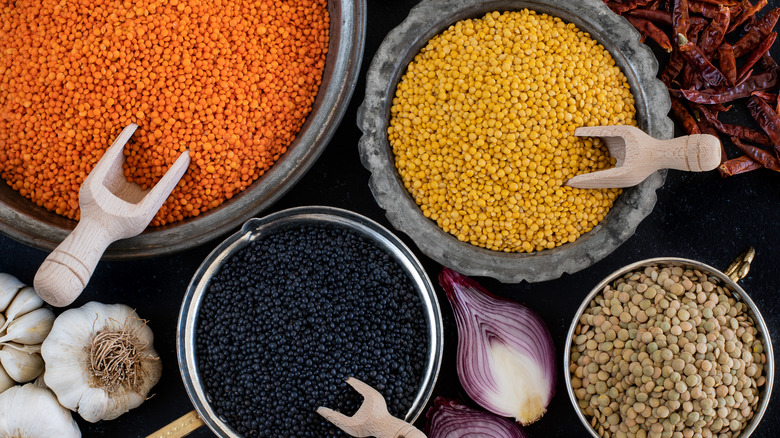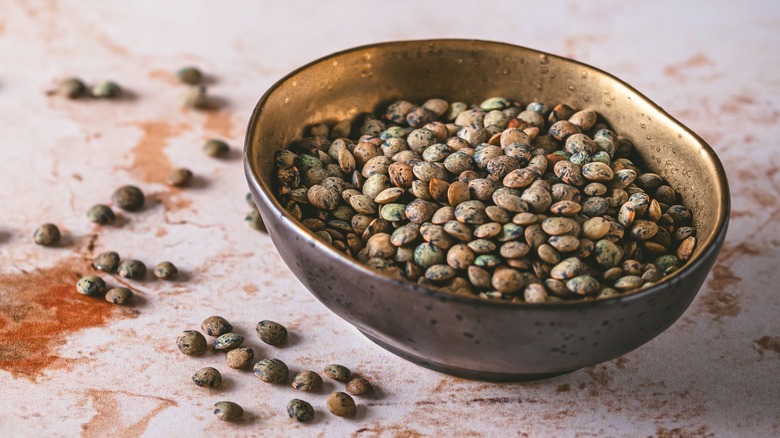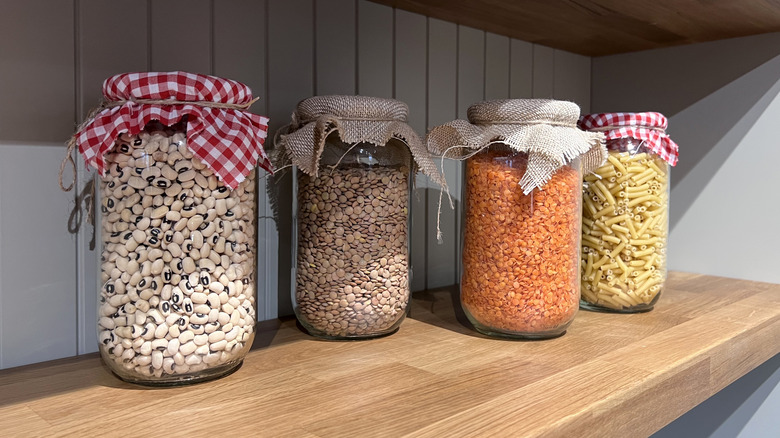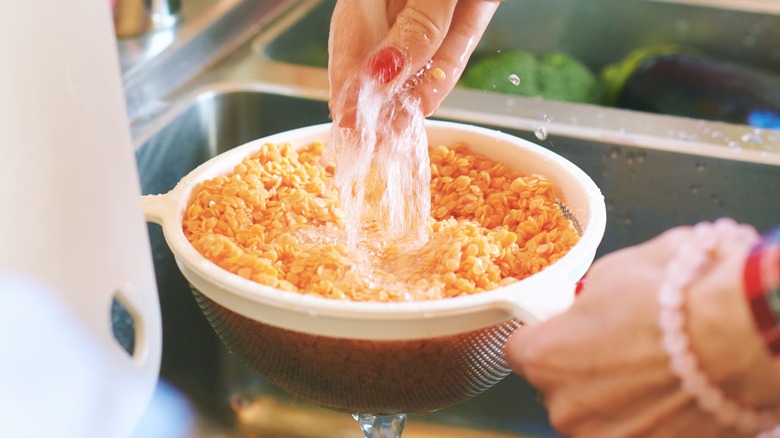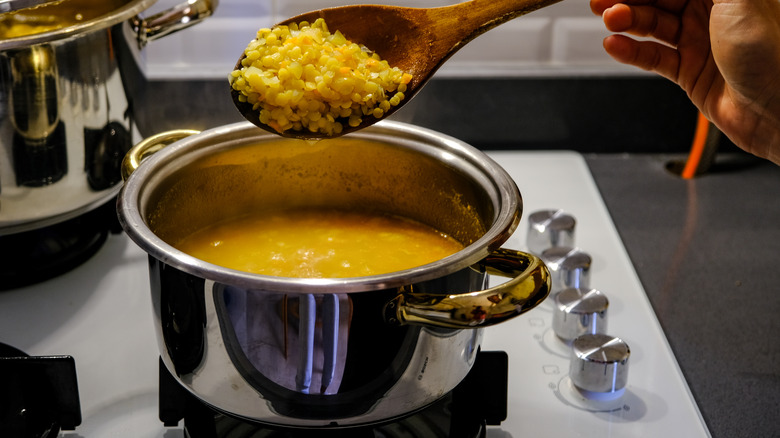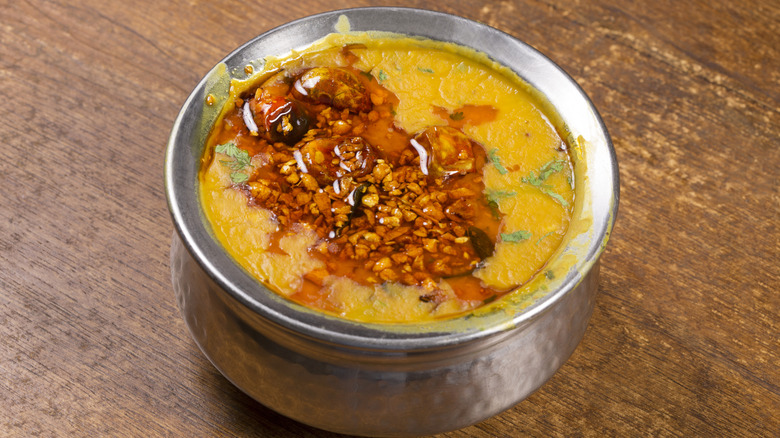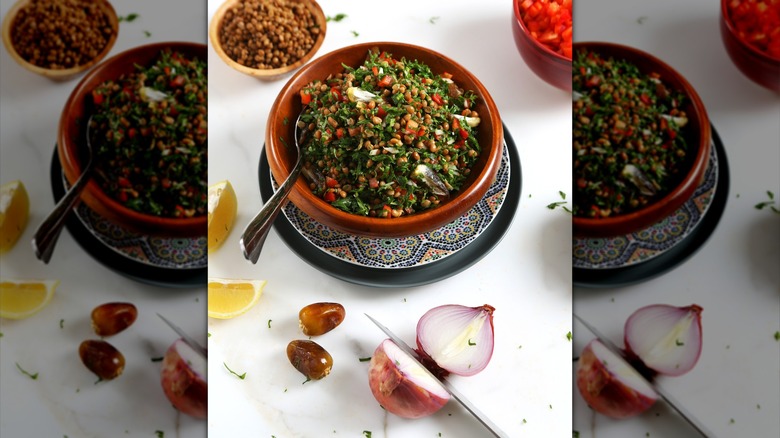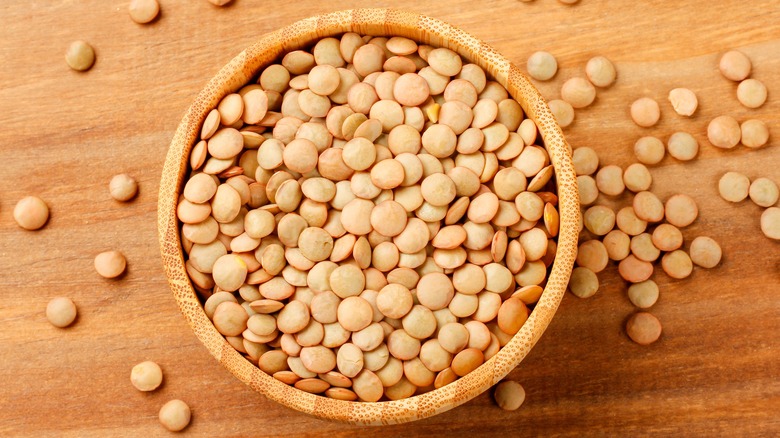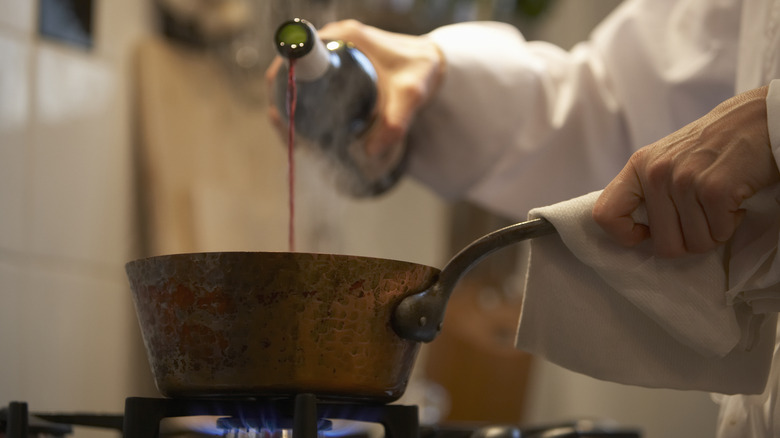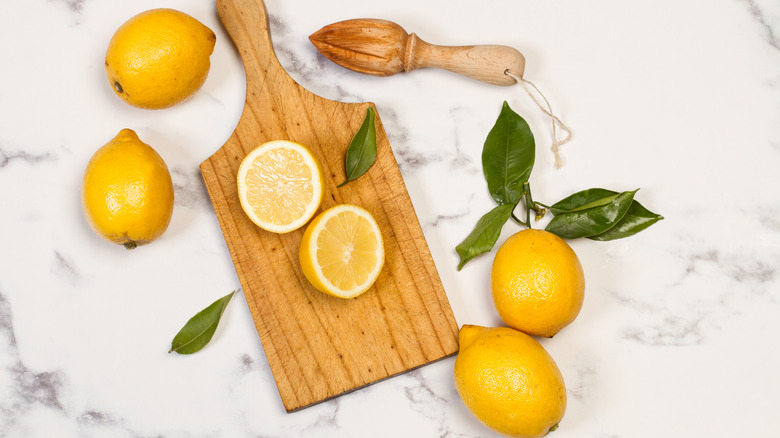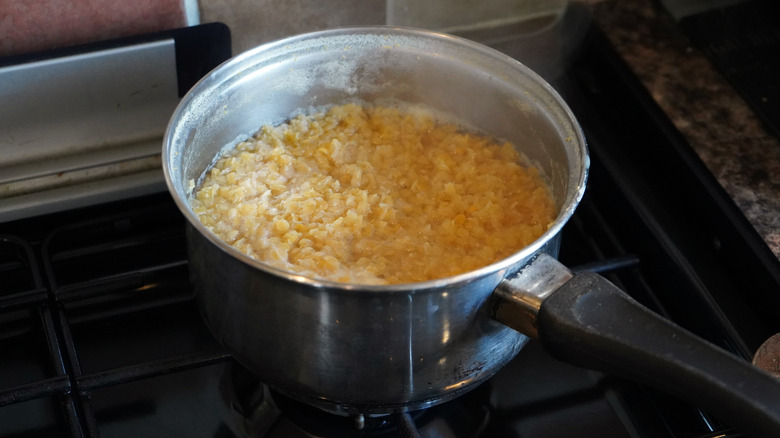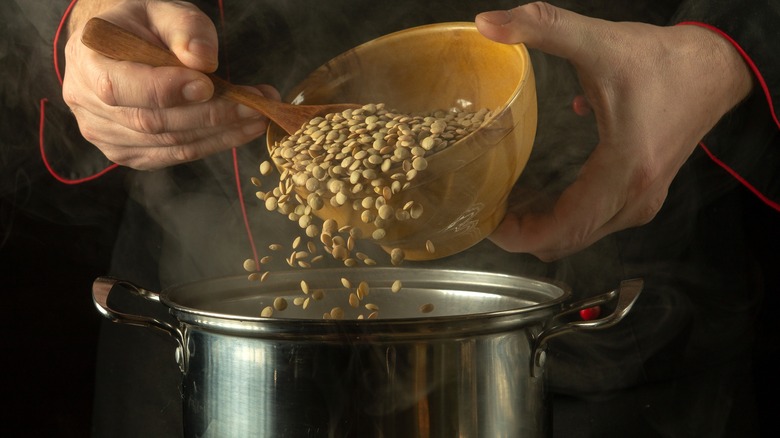Pros Explain Common Mistakes To Avoid When Cooking Lentils
Lentils might not seem like a particular challenge to cook, but many people struggle with them. Plus, some folks think they don't like these little legumes when, really, they've just been cooking them badly for years. There are many mistakes people can make when cooking lentils, but once you know what they are, it's easy enough to avoid them.
Learning how to cook lentils well is totally worth it. They are cheap and packed with protein and other nutrients, making them a hearty ingredient that won't leave you out of pocket. And, cooked well, they're delicious. You might think that you can just go without lentils instead of figuring out how to cook with them, but that's a sad path to find yourself on.
As a vegan, I cook with lentils a lot because they're a perfect meat-free protein source. I also interviewed two lentil experts who dished the dirt on how to cook them. First, I spoke with Kelly LeBlanc, the vice president of nutrition programming at food and nutrition nonprofit Oldways. Then I talked to recipe developer and food blogger Elaine Gordon of Eating by Elaine. With their expert advice — plus my experience as a food writer and recipe developer — I've uncovered the most common lentil-cooking mistakes and how to avoid them.
Not realizing the types of lentils available
A common mistake is not realizing how many varieties of lentils there are — and missing out as a result. You might have just come across green and red lentils and assume that's the end of the story, but there's so much more to it than that. Once you know your options, you can be more adventurous with these varied legumes.
For starters, lentils fall into four main categories: red, green, brown, and black. The red types are split lentils, meaning they've been removed from their skin. This gives them a creamier consistency when cooked. Kelly LeBlanc of Oldways says they're "well suited for creamy soups and stews" because of this — they basically dissolve. Then, you have green and brown types, which are red lentils still inside their skin. They have a firmer consistency and take longer to cook. Black — or beluga — lentils hold their shape well due to their thick skins but have a creamy interior. "I love to add them into salads or even marinara sauce like a Bolognese to serve on pasta for a plant-based protein boost," says food blogger Elaine Gordon. "They are barely noticeable since they are so tiny and not mushy or too firm."
On top of this, you can find subtypes of lentils within these broader categories, including German brown lentils, Eston lentils, Puy lentils, and berry lentils. Plus, there are yellow lentils, which are split like red lentils and are used interchangeably.
Cooking old lentils
Lentils are often the kind of ingredient that ends up at the back of the pantry for years. This leads to the next mistake – cooking old lentils. You might assume that dry lentils pretty much last indefinitely. They're not going to rot or get moldy. It's true to some extent. You're unlikely to get sick from eating old lentils, but they might not cook the way you want them to.
If you've ever simmered lentils for way longer than the amount of time directed on the package and still found them unpleasantly firm, you might have been using lentils that have been sitting around for a while. Old dry legumes often don't cook all the way through, even when you simmer them longer than you're supposed to. So, rather than getting the creamy texture or soft interior that you were hoping for, you're left with something al dente.
Once you know this is something to avoid, it's easy not to make this mistake. Before you get started cooking lentils, check the best before date on the package. If it's gone past this date, lentils are safe to eat but you won't get the texture right. It's also important to store lentils correctly. Transfer open lentils to an airtight container and note the best before date on it, so they don't end up past their best.
Using lentils without washing them
If you've been throwing lentils from the package straight into the pan, you're making the mistake of not washing them. "As with any food found in nature, it is recommended that you give lentils a quick rinse before using them," says Kelly LeBlanc. Elaine Gordon agrees, saying they "need to be washed to remove debris."
Like rice, red lentils can accumulate dust. This is actually starch from the lentils that's formed when they rub together during processing and transport. If you don't rinse your lentils, this can affect the texture due to the excess starch. Failing to wash lentils can also cause foam to form on the water during simmering. This is safe to consume but can be annoying to deal with.
What's more, you may find some dirt in packets of lentils — and occasionally even debris, such as small rocks and pieces of twig. So, not only should you rinse them, but pick them over to check for pieces of debris. It can feel like a pointless and annoying step, but you'd kick yourself for not doing it if you cracked your tooth biting into a rock.
Soaking lentils before cooking them
If you've been soaking lentils before cooking them, you're committing a common misstep. "There is no need to soak lentils," says Kelly LeBlanc. "Unlike dried beans, most lentils can be cooked in about half an hour due to their small size," she adds. Elaine Gordon agrees that it's unnecessary, remarking "soaking is not necessary since they cook and soften quickly."
The fact that they don't need soaking is one of the main reasons to cook lentils over beans. There's no need to decide 12 hours ahead of time that you want to eat lentils for dinner. You can decide on the fly, giving you more flexibility. But, it's not just that you don't have to soak lentils, you actively shouldn't unless you adjust the cooking time. If you soak them and then cook them as long as you usually would, they'll end up overcooked. Soaking starts to soften them, reducing the amount of time they need to simmer. Unless you're keen on doing lentil math, leave them unsoaked and follow the usual cooking instructions. Furthermore, they're generally quick to cook.
Sticking to the same old lentil dishes
It's common to get stuck in a rut when cooking, so don't fall into the trap of making the same old lentil dishes over and over again. They're extremely versatile and it's a shame not to try a range of lentil recipes to make the most of them. If you're lacking inspiration, that's okay, because we have some ideas for you.
Kelly LeBlanc of Oldways has a favorite Ecuadorian-inspired lentil soup that's included in one of the organization's pamphlets. "Our team has been making a Mediterranean variation of red lentil soup that we first fell in love with on a trip to Istanbul in 1993," she adds. Dal is an obvious way to use lentils, but there are variations if you want to diverge from your go-to. "We're especially partial to dal fries, a North Indian variation in which the cooked lentil or pea soup is finished with a mixture of oil (or ghee) and aromatics," notes LeBlanc. You could also try a coconut dal recipe, using coconut milk to add a rich creaminess.
Looking for more ideas? "I love to add black, green and brown lentils to veggie burgers and many Italian dishes such as lasagna, meatloaf, Bolognese sauce, salads, soups, and stews," says Elaine Gordon. "You can add red lentils to thick and creamy soups or stews," she remarks. "I also blend them and turn them into a red lentil hummus dip."
Not adding aromatics when cooking lentils
If you simmer lentils without adding aromatics, you're missing a chance to bring more flavor to the party. "Aromatics like onions, garlic, or herbs can be a delicious way to flavor lentils," says Kelly LeBlanc. You can simply add them to the cooking pot while you simmer your legumes. And, since you'll be picking the aromatics out, you don't even need to prep them too much. Quarter some onions or shallots and put them in the pan, toss in some whole peeled cloves or garlic, add a knob of ginger or a stalk of lemongrass.
"There are no hard and fast rules," LeBlanc assures us. You don't need to follow a recipe exactly, just add some flavorful ingredients and it will add a lot to the taste of your cooked lentils. However, if you find yourself daunted by winging it, LeBlanc notes you can "experiment with different lentil recipes from different cuisines to find the flavor combination you like best." From there, you can change it up as you see fit or just stick with what you know.
Consider the recipe you'll be using your lentils in and use this as a guide. For instance, if you wanted to make an Italian-inspired recipe with your lentils, you might add onions, celery, carrots, garlic, and rosemary as your aromatics. Whereas, if you wanted to use them in an Indian curry, onions, garlic, ginger, and cardamom pods would be nice additions.
Overcooking lentils
Since lentils are small, it's easy to overcook them. It only takes a minute or two to go from perfectly cooked to mushy and falling apart, so you need to keep an eye on them. "Be sure to use your five senses in the kitchen rather than relying on package instructions alone," says Kelly LeBlanc. "This means listening for boiled-over water, smelling to make sure nothing is burning, looking at the simmering pot and the appearance of the lentils, and tasting for doneness," she explains.
Of course, the cooking directions on the package of whatever lentils you're cooking or the cook time in the recipe you're following is a good place to start. However, relying too heavily on this can lead to subpar dishes. There are all kinds of reasons for variations in cooking times, including the size of the lentils and how fresh they are, which means things might not be the same every time.
But, should you end up with overcooked lentils, it's not the end of the world. Some dishes call for a mushier, creamier consistency, such as dal and certain stews. If all else fails and they're too well-cooked for your needs, you can blend them into soup or turn them into a dip.
Undercooking lentils
Overcooking lentils is a problem, but undercooking them is just as bad, if not worse. Split lentils need to cook well to get creamy and melt-in-the-mouth, while those still in their skins should have soft interiors. They're not something you want with a little bite to them.
As with overcooking lentils, Kelly LeBlanc says that "the package instructions can offer helpful clues for how long it might take lentils to cook, but your senses are your best tools." She adds that "it doesn't hurt to peek under the lid to make sure there are no surprises." So, taste them when you think they're ready to make sure they're soft and creamy. If they aren't, give them a couple more minutes and check again.
And, note that you should never eat raw lentils because of lectins they contain in their uncooked state. They aren't poisonous but can give you an upset stomach. Cooking them completely neutralizes lectins, so it's nothing to worry about — as long as you don't eat raw lentils straight from the pack. However, this only applies to dried lentils. Canned lentils are already cooked before canning. So, you can eat these without cooking them further. There are many things you can do with canned lentils (and beans), so they're always an option when you don't want to cook from scratch.
Only cooking lentils in water
Many people only ever cook lentils in water, but you're missing out on an opportunity to add more flavor to your dish. Trying alternative cooking liquids can make all the difference. The cooking liquid penetrates the lentils as they simmer, so it gets into them in ways that flavors just can't once the lentils are already cooked.
Using stock instead of water is an obvious choice but a good one. Most people have some kind of stock or broth on hand — even if it just comes as a powder in a jar. You can mix up what type of stock you use depending on the dish. For instance, if you're looking to make a meat-free Bolognese with your lentils, mushroom stock brings an umami richness.
However, stock certainly isn't your only option. Alcohol is also a great choice when you want to make lentils that taste amazing. You can use basically any alcohol that you'd use in cooking other dishes. Wine is a great choice, as is beer or hard cider. Dark beers have a complex maltiness that works beautifully in hearty stews. But, don't use alcohol alone or it might taste too boozy. Add the alcohol to your lentils and let it cook off for a few minutes before adding in water or stock to dilute the flavor.
Cooking lentils with acidic ingredients
Acidic ingredients, such as lemon and vinegar, bring brightness to recipes. Since lentils are quite earthy, it seems to make sense to add something acidic while cooking them, but this is a mistake. When you add acidic ingredients during the cooking process, it can stop lentils from fully softening.
So, if you ever find these legumes aren't cooking properly and you know the bag is fresh and in-date, excess acidity could be the issue. The solution is an extremely simple one — add the acidic ingredients once your lentils have softened to the consistency you want them. This way, you get both the brightness that acidic ingredients bring and the soft, creamy texture that lentils are prized for.
There's an added bonus to adding lemon and lime later in the cooking process — the flavor is better. When you cook citrus juice for too long, it can get lost among the other flavors. Squeezing it into your dish just before serving preserves those fruity, floral notes.
Letting lentils boil too vigorously
Lentils are said to be good luck on New Year's, but starting the year with lentils that are mushy and falling apart doesn't sound that lucky. That's why you should avoid letting them boil too vigorously. When you cook lentils at a rolling boil, rather than a gentle simmer, they can become mushy. That's fine in some cases, such as when you want red lentils to cook down into a sauce, but when you want them to hold together, boiling can be an issue.
Rectifying this is simple — just don't let them boil vigorously. You need to get them bubbling — just sitting in a bath of hot water won't cook them. However, it doesn't need to be a full boil. Bring them up to a rolling boil and then turn them down to a steady simmer and keep them there until they're cooked. It means you need to keep checking in on them, but this isn't a big issue. Some people find it easier to cook them without a lid or with a clean glass lid to keep an eye on how they're cooking.
Using too much or too little cooking liquid
Using the right amount of water — or other liquid — to cook lentils in is a balancing act. It's easy to use too much or too little. This might not seem like a big deal, but it can lead to several issues. That's why it's important to get it right.
If you use too much cooking liquid, your dish can turn out soupy. Some lentils you can drain if you use too much water, but if you're cooking red lentils or you're cooking a dish where you simmer the lentils right in with the other ingredients, draining isn't as easy. When you use too little, all the liquid will be absorbed before the lentils are cooked and you'll either end up with a dish that's burned or undercooked.
The correct ratios of liquid to lentils depend on the cooking method and the type of lentils. However, a good place to start for lentils cooked on the stovetop is 2 ½ cups of liquid to each cup of red or yellow lentils, or 3 cups of liquid to every cup of other lentils, such as brown or green.
